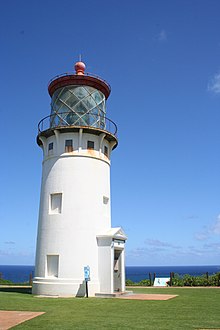Kilauea Point

Kīlauea Lighthouse, 2008
|
|
|
Hawaii
|
|
| Location |
Kilauea Kauai County Hawaii |
|---|---|
| Coordinates | 22°13′53.8″N 159°24′7.2″W / 22.231611°N 159.402000°WCoordinates: 22°13′53.8″N 159°24′7.2″W / 22.231611°N 159.402000°W |
| Year first constructed | 1913 |
| Automated | mid-1970s |
| Deactivated | 1976-2013 |
| Construction | reinforced concrete tower |
| Tower shape | cylindrical tower with balcony and lantern |
| Markings / pattern | white tower, red lantern roof |
| Height | 52 feet (16 m) |
| Focal height | 174 feet (53 m) |
| Original lens | Second Order Fresnel, clamshell or "bivalve" shape |
| Range | 9 nautical miles (17 km; 10 mi) |
| Characteristic | Fl W 10s. |
| Admiralty number | G7500 |
| ARLHS number | HAW-004 |
| USCG number | 6-29737 |
| Managing agent | Kīlauea Point National Wildlife Refuge |
Kīlauea Lighthouse is located on Kīlauea Point on the island of Kauaʻi, Hawaiʻi in the Kīlauea Point National Wildlife Refuge.
Kīlauea Point, a narrow, lava peninsula protruding from the northern shore of Kauaʻi, was purchased from the Kīlauea Sugar Plantation Company in 1909 for one US dollar.
Before construction could begin, a method for delivering supplies to the point had to be developed. Due to the lack of good roads from the Nawiliwili harbor, the decision was made to bring the materials in by sea. The lighthouse tender Kukui would anchor offshore and then dispatch small boats with supplies to a cove near the point. Since there was no beach landing, the boats would anchor to cleats cemented into the lava rocks at the point. A boom derrick, constructed on a ledge above the water, would pluck the supplies from the boats and place them on a loading platform 110 feet (34 m) above the water.
Finally, after almost four years of planning, construction began in July 1912 and the light was dedicated on May 1, 1913. The tower was built in a Classical Revival architecture style out of reinforced concrete. The tower is a slightly tapering cylinder about 52 feet (16 m) high. The upper portion has a steel circular walkway with handrail. The lens one of only seven second-order Fresnel lenses remaining in a lighthouse in the US. Barbier, Bernard, and Turenne manufactured the lens in Paris, France. The 9,000-pound (4,100 kg) lens floated on mercury and compressed air. The lens was rotated by a system of pulleys powered by weights that needed to be reset by an operator every 3.5 hours. An oil storage house was built 155 feet (47 m) southeast of the light, and a small engine house in a small cove below the point. About 1,000 feet (300 m) south is a residential area with three small stone houses. Each house and the lighthouse itself has a water storage tank.
The point is accessed from Route 56 (called Kuhio Highway), north of the town of Kīlauea. On June 29, 1927, the United States Army Air Corps pilots of the airplane Bird of Paradise, Lester J. Maitland and Albert F. Hegenberger, were attempting the first transpacific flight from California to Hawaii. An hour before dawn, aware that they were slightly north of their planned course and with their directional radio receiver not functioning, they spotted the Kīlauea Lighthouse as planned to verify their position.
...
Wikipedia

